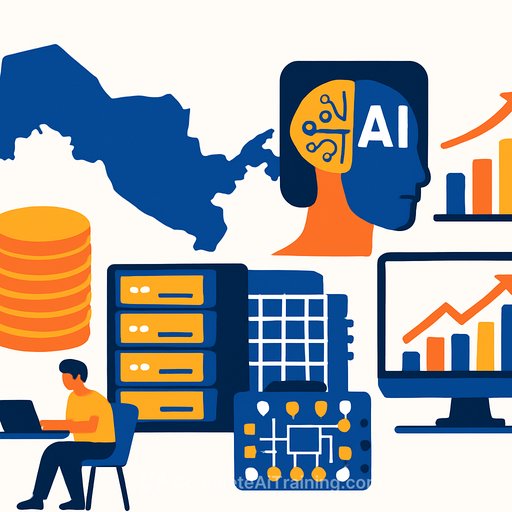Uzbekistan's AI Push: What HR Leaders Need to Do Now
Artificial intelligence is moving from pilot to practice across government and industry. Uzbekistan has climbed 17 spots to rank 70th among 188 countries for AI use and first in Central Asia. That momentum creates a clear talent signal: organizations will need new skills, new roles, and new ways to develop people.
The country approved the Artificial Intelligence Development Strategy 2030 and launched a dedicated center under the Ministry of Digital Technologies. A $50 million fund backs 86 AI projects across healthcare, education, agriculture, energy, transportation, ecology, and finance. A national supercomputer cluster is also in progress to power large-scale deployments.
Why this matters for HR
AI adoption isn't just a tech decision-it's a workforce decision. Every new use case demands hiring plans, reskilling pathways, and governance. HR leaders who prepare now will secure talent early, contain costs, and reduce project risk.
Key initiatives HR should track
- Strategy 2030 and the new AI center set direction and standards-expect hiring demand for data, ML, and AI ops roles.
- $50 million portfolio across 86 projects will drive sector-specific talent needs (clinical data in healthcare, precision agritech, grid optimization, and more).
- Supercomputer cluster implies demand for high-performance computing, MLOps, cybersecurity, and data center operations roles.
- National focus on best practices and private-sector collaboration opens space for cross-border hiring and expert partnerships.
Talent pipeline: education and early-career
Uzbekistan is building AI capability from school level-upgrading teacher skills, curricula, and textbooks. The "One Million Leaders of Artificial Intelligence" program launched aistudy.uz and omp.aistudy.uz with five free online courses, aiming to train one million young people by 2027.
For HR, this is a structured pipeline. Build internships, apprenticeships, and junior pathways that connect to these platforms. Align job descriptions with emerging competencies so graduates can step into real projects faster.
Recruitment opportunities: hackathons and regional reach
AI hackathons will run across all regions. The HealthTech AI Hackathon in Nukus proved the model and will expand to education, water management, the judicial system, and entrepreneurship.
Use these events as live assessments. Offer fast-track interviews, problem briefs tied to your backlog, and micro-internships for standout teams. It's a low-cost way to spot practical talent.
Infrastructure growth means new roles
With modern data processing centers and investor-friendly conditions on the agenda, expect hiring needs in:
- Data center operations: site reliability, facilities, network engineering, and security.
- AI platform teams: data engineering, MLOps, model monitoring, and governance.
- Risk and compliance: data privacy, model risk, audit, and incident response.
What to build inside your organization
- AI job architecture: define levels, competencies, and career paths for data, ML, AI product, analytics, and AI ethics roles.
- Skill taxonomy: baseline AI literacy for all employees; role-based skills for technical and non-technical tracks.
- Comp and benefits: market-informed bands for scarce skills; project bonus structures for delivery milestones.
- AI center of enablement: small team that sets standards, templates, and training so each business unit can execute safely.
- Change management: train managers to redesign workflows, KPIs, and incentives as AI tools roll out.
Practical steps for HR in the next 90 days
- Run a skills inventory: map current capabilities to the 86 project domains (healthcare, energy, finance, etc.).
- Create a two-track training plan: baseline AI literacy for all; advanced tracks for data, engineering, and product roles.
- Launch a talent partnership plan: universities, aistudy.uz/omp.aistudy.uz cohorts, and regional hackathons.
- Pilot a project-based hiring sprint: job trials or short contracts tied to AI backlog items.
- Set AI governance basics: data handling, model monitoring, and ethical review with HR, Legal, and IT.
Sector-specific hiring cues
- Healthcare: clinical data specialists, NLP engineers, AI quality and safety analysts.
- Agriculture: geospatial data analysts, IoT integration engineers, field data ops.
- Energy and transportation: optimization engineers, demand forecasting analysts, telemetry data leads.
- Finance: fraud analytics, risk modeling, model validation, and data lineage roles.
- Education: learning analytics, content AI, and teacher enablement programs.
International collaboration and best practices
There is a push to learn from domestic and global experience, including experts abroad and private sector leaders. Use this to justify cross-border hiring, visiting fellows, and short-term expert residencies.
For a policy and benchmarking view, explore the OECD's AI resources for responsible adoption. OECD AI Policy Observatory
Training resources for your workforce
If you're building role-based learning paths and certification plans, map them to your job architecture and project portfolio. Curate short courses for literacy and deeper tracks for engineering, analytics, and product.
You can browse role-focused AI programs here: Complete AI Training: Courses by Job
The bottom line for HR
Funding, infrastructure, and education efforts are in motion. The mandate is clear: speed up hiring readiness, reskill at scale, and set governance. Teams that move first will deliver faster and reduce hiring pressure later.
Support national programs, connect to hackathons, and formalize your AI job architecture now. That's how HR turns policy momentum into real capability.
Your membership also unlocks:






